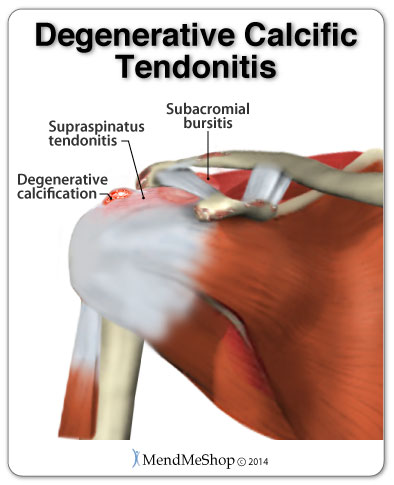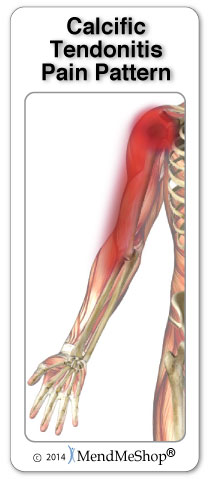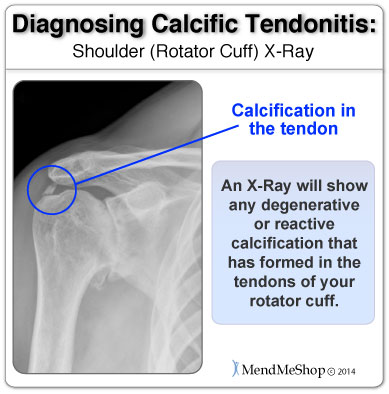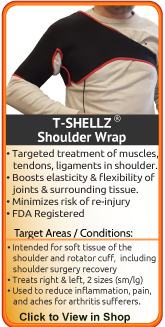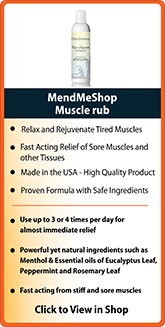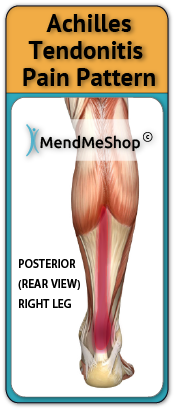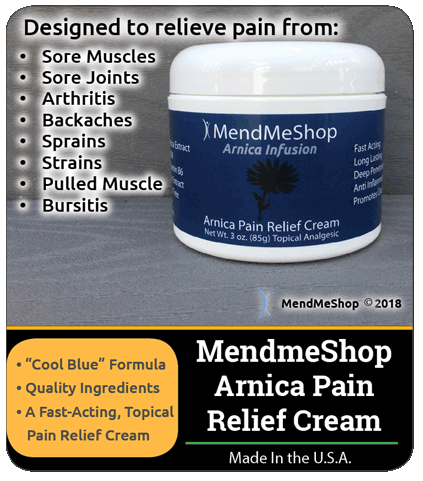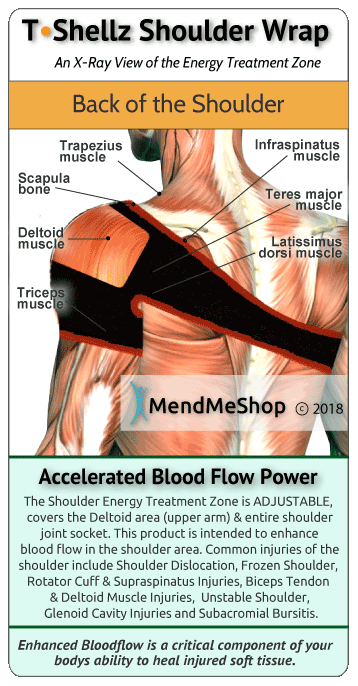Calcific Tendinitis
You might be suffering from Calcific Tendonitis in your Rotator Cuff if:
- You have pain in your shoulder lasting a few weeks or months with no relief.
- You feel a sharp pain in your shoulder that shoots down your arm.
- You have a lot of pain that wakes you up at night or when you get up in the morning from laying on the affected shoulder.
- You're suffering from reduced motion in your shoulder and an inability to raise your arm and shoulder up without extreme pain.
- You sometimes feel a snapping, catching or weakness in your shoulder.
If any of those statements are true for you or you're suffering from on-going pain in your shoulder that intensifies over time and suddenly goes away then you might be suffering from "calcific tendonitis" in your rotator cuff. Calcific tendonitis is an injury that not a lot of people have heard about, and as a medical term the name for this condition is sometimes referred to as "rotator cuff disease".
Rotator cuff disease is really an injury or condition involving any injury or damage in your rotator cuff - to the tendons, muscles, or bursae. Calcific tendonitis means specifically the formation of bone spurs in the middle of your rotator cuff tendons. These spurs will form on their own naturally and will also go away on their own. While they're there though, they can cause pain, stiffness, and loss of movement in your shoulder and arm.
Calcific tendonitis is one of those injuries that can really bring down the quality of your life. In the early stages you might not feel a lot of pain, but the pain will increase as this condition goes on. The pain you feel will start to interrupt any of your normal daily tasks and make living life harder than it really needs to be. You might even start experiencing some sleepless night from the pain, or develop other conditions (like frozen shoulder) from resting and avoiding use of your injured shoulder.
What is Calcific Tendonitis?
We use tendons everyday to stretch, pull and move, we have about 400 tendons in our body! Tendons are cord like pieces of soft tissue that connect our muscles to our bones. Calcific Tendinitis is a condition where calcium deposits (bone spurs) build in the middle of the tendon tissue. This condition is basically a natural chemical reaction with other tissues in the body the results in the formation of these spurs (an action called 'calcification').
What Causes Calcific Tendinitis?
There is no known cause of calcific tendinitis. All that medical professionals and doctors know now is that calcific tendonitis is NOT caused by: trauma to the area of injury, a sport / activity related injury and it's rarely part of a systemic disease. So far this condition is known as a natural process than can happen to some people and not others.
The Two Types of Calcific Tendonitis Of The Shoulder Affecting The Rotator Cuff
Degenerative Calcification
Aging and normal (everyday) activities can cause wear and tear on the tendons in your shoulder. This wear and tear slowly weakens your tendons over time and can cause small tearing or fraying (kind of like a rope frays as it's used). Aging also decreases the blood flow to the tendons of the rotator cuff. Normally, degenerative calcification affects people over the age of 40.
Overworking and overusing the shoulder can cause tendonitis. Tendonitis is a condition that has resulted in small microscopic tears in the tendon tissue. As a part of the normal healing process your body will react to this tendonitis with swelling and inflammation in your shoulder. Unfortunately aging of tendon tissue reduces blood flow to the rotator cuff tendons, starving the tissue from oxygen and nutrients needed for natural healing as well. This is bad news because you need blood to heal the tendon completely. In this case your tendon will make calcium deposits in your tendon tissue instead of using natural blood flow to actually make strong, healthy tissue fibers.
Reactive calcification
There is still some mystery surrounding the cause of reactive calcification. The stages of this type of calcific tendonitis can start when you're younger and progress until you're in your 40's (or even later in life). So far there is no clear cause of reactive calcification.
This condition normally affects younger women more so than men. There are 4 stages of reactive calcification:
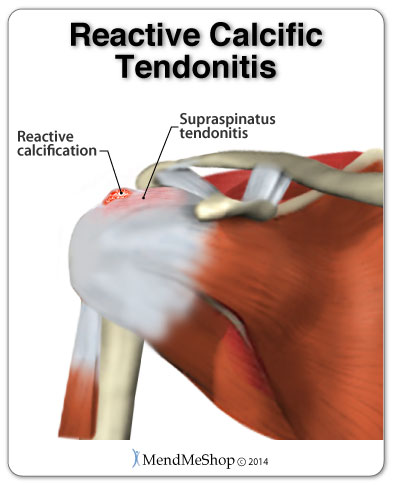 - Stage 1: Pre-calcific - A natural chemical reaction in the tissue causes the calcium to form inside the tendon itself. The calcium deposit will get bigger and look like a piece of chalk (hard, dry).
- Stage 2: Resting - The chalk-like calcium deposit enters a resting period and may or may not be painful. At this point the deposit may be large enough to reduce the range of motion in your shoulder.
- Stage 3: Calcific - This is the most painful part of all the stages. The body is trying to break down the calcium and reabsorb it into the tendon tissue. This stage sparks inflammation and the calcium crystals turn into a 'liquid' much like the consistency of toothpaste, and may leak into the surrounding tissue (ultimately causing other conditions like shoulder bursitis / subacromial bursitis).
- Stage 4: Post-Calcific - The healing cycle continues in the tendon and remodelling helps to create new tendon tissue. The pain decreases as the calcium deposit is re-absorbed into the tissue and disappears completely.
Symptoms of Calcific Tendinitis
If you're suffering from calcific tendinitis you may experience:
- Pain and stiffness that lasts for a few weeks to 2 months and suddenly disappear. If your calcific tendinitis injury comes back a number of times, you could now have a chronic condition and notice pain that lingers for a few months to years.
- Pain that radiates from the point of your shoulder half way down your arm.
- Pain that intensifies when you raise your arm above your shoulder level.
- Reduced range of motion in your arm and shoulder.
- Pain that wakes you up at night if you're sleeping on your side or your affected shoulder.
- Snapping, catching or/and or weakness of your shoulder.
Calcific Tendinitis Diagnosis
Visiting your doctor when you have pain is always recommended, as there are many possible issues that can happen in your shoulder.
To begin with, your doctor will gather a medical history about you and your current condition and symptoms. They'll ask about the intensity of your pain, how long your symptoms usually last and the limitations you're experiencing. Details about when it started and whether or not you have ever had treatments for this or a similar condition in the past are very helpful in assessing your shoulder injury.
Your doctor will also look and feel the bones and soft tissue in your shoulder to see what kind of pain you're having. They'll be looking for any differences between you injured shoulder and your healthy shoulder. This will help them to feel any abnormalities - like mild or severe inflammation, bone deformities, atrophied muscles (muscles that have wasted away due to injury), redness and/or warmth on the skin.
One set of symptoms can result in multiple diagnoses. An X-ray, MRI or visual ultrasound is needed in order to clearly diagnose calcific tendinitis and know the extent of the soft tissue damage. Any calcium deposits in your tendons should show up clearly in an x-ray.
How Do I Cure Calcific Tendonitis -
What You Can Do!
The good news is that most cases of calcific tendonitis will heal with simple home conservative treatments and surgery is often not needed!
It's generally understood by doctors and surgeons, that surgery will introduce more scar tissue into the shoulder. This added scar tissue will be problematic, requiring visits to the clinic and conservative treatment options post-surgery. When it comes to calcific tendonitis there's only 1 surgical option for treatment - removal of the calcium deposit through arthroscopic, needling or open surgery. This is why surgery is only performed as a last resort for chronic calcific tendonitis injuries that won't heal with conservative treatment methods, or calcium deposits that won't re-absorb back into the tendon.
Some conservative treatment methods recommended include:
- Rest - This is important for initial healing to reduce pain, swelling and inflammation in the early stage of your calcific tendinitis because without proper rest you're at risk for increased pain or inflammation in your shoulder. Without proper rest you could end up making your calcific tendonitis even worse and turn an acute injury into a chronic one.. Too much rest can also be harmful as joint immobility can actually cause stiffening, overcompensation and atrophy (shortening & wasting away of soft tissue). This is why rest should be used when reducing initial pain and swelling, but should not be considered for more long-term conservative treatment.
- Avoid Activities that Caused Your Injury - While resting your shoulder, it's important to avoid activities that may have caused your injury in the first place or activities that increase your pain. This would include raising your arm above shoulder level, or using your injured shoulder for everyday activities. Continuing on with regular activities will not only make your injury worse, but trying to 'work around' your injury will eventually give rise to over-compensation injuries in other areas of your body - creating major setbacks to your recovery.
- Apply Cold Compression - Immediate application of a Cold Compress or Ice Pack will help manage pain while getting rid of your swelling and inflammation. Immediate pain relief and reduced inflammation can also relieve some of the pressure that's being placed on your rotator cuff tendons and stop your injury from getting worse.
- Use a Shoulder TShellz Wrap® (Circulatory Boost device) Once The Swelling is Down - You can use your own blood flow to maximize your rehabilitation, maintain healthy blood flow to your soft tissue, decrease recovery time, and reduce re-injury risk. Promoting blood flow to the injury using a warming treatment will help to minimize the growth of scar tissue and increase flexibility. This is why we recommend TShellz Wrap before undergoing activity - an increase in flexibility should help reduce risk of further injury while also assisting in the battle against atrophy.
- Avoid Over Compensating for your Injury on your "'Healthy' (Non-Injured) Side - Many people will start limping or carrying objects with their opposite arm to compensate for their tendon injury. Our bodies can adapt easily to any changes, including a tendonitis injury. This quick adaptation could mean that you're already compensating for your injury without even knowing it!
When you compensate for your injury by using your opposite ('healthy') arm, leg, shoulder, knee, foot, etc. - then you are putting more weight and pressure on that side of your body. In many cases, your dominant side was injured (if you're right-handed this would be your right side) so your weaker side is trying to pick up the slack! The pain, stiffness, swelling and inflammation you then get on your 'healthy' side is something referred to as 'over-compensation pain'. Over-compensating for your injury can lead to other injuries and so that's why over compensation should be avoided at all costs OR treated with the same conservative treatment methods as your tendon injury.
- PT - Surgery is usually the last resort. This means doctors or surgeons typically won't perform a surgery until they feel that their patient has put effort into treating their injury with conservative treatment methods. This includes 4 to 6 months of visits to a PT. If you haven't experienced any improvement in your condition during that time then surgery may be considered. Your PT may ask you about using clinical ultrasound (which uses sound waves) to help reduce the size of the calcium deposit. Ultrasound needs to be repeated often in a six to eight week period up to 24 times visits to see full results. Another treatment your physical therapist might want you to try is a shock wave treatment (ECSW).
- Stretch Your Shoulder - Stretching your joint in PT and at home will help you to regain your range of motion much faster than not stretching at all. Stretching in many ways is key maintaining good Range of Motion (ROM) in your joint, and stretching can be made much easier with use of a TShellz Wrap® before to warm up soft tissue, and a Cold Compress or Ice Pack treatment after to prevent any return of swelling and inflammation.
Restricted Movement Is Risky If It Goes On For Too Long
For acute (new or recent) Achilles tendon tears that have the ability to heal on their own - your doctor may even cast your foot in a toe pointed position (in something called a "hanging enquinus cast") or in a removable brace/splint. A removable splint can be very helpful to prepare you for PT sessions and mobility exercises.
Prolonged use of a cast, removable splint, or long-term rest (restricted movement) without proper exercise or stretching can make your Achilles tendon injury worse. If your Achilles tendon remains completely immobilized and at constant rest, the ends of the Achilles tendon (where it attaches to bone or other muscles) will begin to fill in with scar tissue as part of the healing process. You may also have on-going symptoms of pain, swelling and inflammation, and even poor blood flow circulation.
Lack of proper blood flow and growth of scar tissue will decrease the natural length of the tendon (atrophy) and tighten tissue, reducing the flexibility between your ankle and foot. Your ability to push off with your foot in certain activities such as running, jumping, or going up and down stairs all become compromised. You are also at an increased risk of re-rupture of the tendon, especially if the initial injury was large and required surgery in the first place.
If your doctor has decided that your calcific tendonitis can be treated with conservative treatments, you can join our many customers who have had great success in treating themselves at home with conservative treatment options such as the Shoulder TShellz Wrap®.
If you need to have surgery, talk to your doctor about using these same products for post-surgery recovery. You'll find them effective for reducing post-surgery inflammation, enhancing range of motion and minimizing the growth of scar tissue in your shoulder.
What if You Need Surgery?
Whether you need to have surgery and the type of surgery you'll have depends on the severity of your calcific tendonitis. The longer you've waited to have surgery or try conservative treatment methods will also be a factor to decide if you need surgery.
Has it been weeks or months since the injury?
An acute (recent) case of calcific tendonitis is usually treated with conservative treatment methods, like rest, minimizing activity, cold compression and Circulation Boost as we mentioned before.
Doctors and surgeons will always avoid surgery if possible because recovery from the surgery can be a lengthy process - especially because the calcium deposit is being removed from your tendon. Doctors always prefer minimally invasive treatments which is why they suggest conservative treatment first. Your doctor and surgeon know that a surgery will involve altering the structure of your foot, and so they will recommend treatment to avoid surgery at all costs.
Scar tissue will be problematic for long-term recovery after surgery.
As with any surgery there are risks to every procedure depending on a lot of factors, including your age, the severity of your injury and your level of health going into the procedure. It's always best to discuss all possible risks and complications with your doctor, orthopaedic specialist and/or surgeon before the procedure. It's important to be aware of the risks you may face with any procedure intended to fix or relieve pain from your calcific tendonitis.
If you've exhausted all forms of conservative treatments and you still have calcific tendinitis you and your doctor may decide to move forward with surgery. There are few types of procedures or surgeries they may preform:
Minimally Invasive Procedures
Your doctor may suggest trying a procedure called lavage. During this procedure your doctor will insert two large needles into your shoulder and inject sterile saline (salt water solution). The salt water is used to rinse the tendon, and sometimes this rinsing method will help to loosen up your calcium deposit. If the lavage treatment is successful your body will have an easier time re-absorbing the calcium deposit. It could speed up healing and may reduce pressure in the tendon, reducing your pain.
Your doctor may also suggest needling. For this procedure the doctor will attempt to break up the calcium deposit by repeatedly inserting a needle in the area. They also may or may not inject a saline (salt water) solution at the same time.
Arthroscopic Surgery
For this surgery your surgeon will make small incisions in your shoulder then insert tools and a camera (arthroscope) to remove the calcium deposit and see inside your shoulder joint. Sometimes the surgeon will use the needling technique or make a small incision in the tendon and tease out the calcium with a hook. This type of surgery is much less invasive and you can return to daily life much sooner.
Open Surgery
If an arthroscopic procedure can't be done, your surgeon might use an open incision in the skin to expose the area in the shoulder where the calcium deposit is in the tendon. The calcium deposit would then be cut out and the edges of the tendon where the calcium attached itself are also cut away (a process called debridement). After this the remainder of the tendon is stitched back together. This is a much more involved surgery than an arthroscopic procedure - so you may need to wear a sling for up to 3 days and start range of motion exercises at that point.
Conservative Treatment Methods are also Recommended by Your Doctor for Recovery after Your Surgery
Remember that surgery isn't the end of your journey, it's just the beginning of a new chapter. Your rehabilitation efforts will have an important impact on how soon you can return to living and enjoying your normal daily life.
Your rate of recovery after the surgery will depend on how dedicated you are to the conservative treatment method recommended by your doctor, the type of procedure that you had and your efforts in the PT clinic.
No two rehabilitation plans are alike - Generally speaking, the less invasive your
surgery is, the quicker your road to recovery will be.
Use Conservative Treatment Methods For Calcific Tendinitis
If you suspect you have calcific tendonitis,
- Usually conservative treatment methods are all that's needed to treat calcific tendonitis, surgery is only ever used if long-term conservative treatment methods don't work or if you're suffering from a chronic case of calcific tendonitis. Conservative treatment options for calcific tendonitis typically includes rest, icing of the injury, avoiding activities that cause or worsen the pain that you're feeling, and anti-inflammatory over-the-counter medication (reference: 1, 2).
- Second, if your doctor has decided that your injury can be treated with conservative treatment options, then you'll find that many of our customers have had great success treating themselves with our powerful conservative treatment product - the Shoulder TShellz Wrap®.
- Or, if surgical intervention is required, talk with your doctor about using these same products for post-surgery recovery as you'll find them to be effective for reducing post-surgery inflammation, enhancing range of motion and reducing scar tissue growth. Keep in mind that the TShellz Wrap® should only be used a minimum of 6 weeks after surgery and once you have been assigned home stretching from your doctor or PT - basically not until at least 6 weeks after surgery)
When the calcium deposits are being reabsorbed, the pain can be especially bad. There are a number of ways to relieve your pain with conservative treatments.
Conservative Treatment Step 1: Reduce The Initial Inflammation
Inflammation is the body's natural response to an immediate shoulder injury and is a normal part of the healing process - helping to reduce tissue infection in the early stages of injury. Swelling, pain, heat sensation, redness, and loss of function are the main symptoms experienced.
The combination of rest, topical pain relief cream and minor amounts of cold is the gold standard in medicine for minimizing tissue damage and reducing inflammation after injury or activity. It serves as a critical bridge into the next phase of the healing process.
Conservative Treatment Step 2: Enhance Blood Flow to the Injured Soft TissueTendons,ligaments, cartilage, and some muscle fibres are dense tissues. As a result, they naturally receive limited blood flow and this is precisely why injuries to these tissues take so long to heal. The challenge is, how do you effectively increase blood flow to these tissues?
- Rigorous exercise is out of the question as it will lead to further injury.
- Visits to the clinic are helpful, but that only happens a few times a week.
It is through the blood the body carries the nutrients and oxygen that injured tissues rely on for recovery.. It is well known that increased blood flow helps your body accelerate the healing process.
This is why the TShellz Wrap® is such an important tool. The whole purpose of the wrap is to accelerate blood flow to soft tissue in the treatment area. The end result; you relax the blood vessels within soft tissues of the treatment area. The vessels will naturally expand and allow for more blood flow to reach the very tissues you are trying to heal. In addition, this process will help clear the area of toxins and excess fluid build up, thereby reducing inflammation.
Who Should Use the TShellz Wrap®
We recommend the use of a TShellz Wrap®:
- If you are dealing with tendonitis, then a TShellz Wrap® will provide the all-important function of boosting blood circulation in the treatment area (Localized Enhanced Circulatory Response).
- If you are dealing with conditions affecting your range of motion such as tendinosis, tenosynovitis, or even arthritis.
- If you have a chronic tendon condition that has lasted for years- this device is intended to kick start the recovery process to help strengthen the surrounding and supporting tissues. Many of our past clients had suffered for years, then were completely amazed at the results only after a few months of treatments.
- If you are still working with an injured tendon, the TShellz Wrap® will help relax injured soft tissue prior to work and after a day at the job.
- If you are still trying to enjoy your favorite activities such as gardening, hiking, or golf, etc - use the TShellz Wrap® prior to activity to help reduce chances of re-injuring or re-aggravating those targeted tissues.
- If you are suffering from tendonitis and want to treat the major source of it. Through overuse or degenerative changes, soft tissue in the affected area will tighten and constrict. The application of a TShellz Wrap® to the area is intended to relax tendons and muscles, reduce pain and inflammation. It is our position that relaxed and more flexible soft tissue will help reduce risk of further damage.
- If you are experiencing atrophy - this is a treatment we recommend to use on a regular basis, by enhancing blood flow and elongating soft tissue.
- If you have been to a clinic for some form of massage or stretching and your PT or physician has recommended conservative treatments for home.
- If you have a soft tissue injury and need surgery, then you will find the T•Shellz blood circulation boost to be a powerful tool after surgery to help surgically repaired tissues rebuild for long-term health. (once the surgery wound has healed and your physician has given the ok - 6 weeks after surgery minimum)
- If you are experiencing atrophy in the area and want to reduce the chance of re-injury while stretching - this is a perfect treatment to use every time before you stretch.
Increased Blood Circulation = Increased Healing Rate
What Else Makes the Shoulder TShellz Wrap® So Special?
We believe the TShellz Wrap® to be one of the most effective treatments to stimulate blood flow to dense, injured tissues such as muscles, tendons, ligaments, and other similar tissues.
We can promise that you will receive a product that is designed to be safe and does what it is supposed to do...quickly relieve pain and aid in the recovery from tendon, muscle and other soft tissue injuries.
The unit plugs into a standard wall outlet to get its power. The nice thing about the power supply is that the same unit can be used in North America and overseas as well. It has the capability to operate between 110v and 230v. It has a special controller that can be set for 3 different power levels of application (3=High, 2=Medium, 1=Low). The cord is long so you can sit or lie comfortably and watch TV, read or surf the net while you're using it.
Treatments are max 30 minutes in duration and the device can be worn over clothing. This allows you to use the device at work, at home, or really anywhere you have access to an electrical outlet.
A Recap of the Benefits of the TShellz Wrap®..
- Targeted applications for most areas of the body
- It can be used before exercise to warm up tissue in the treatment area to reduce the risk of injury
- FDA Registered medical device for use in home or clinics - very high quality
- Increases flexibility of tissues (reducing the re-injury factor)
- It soothes pain and whisks away toxins
- Carbon fiber Energy Pad is strong, lightweight, and flexible - contours very easily
- Enhanced blood flow provides an accelerated healing rate that will save time and money when associated with doctor or physical therapist visits
- A boost in blood flow will maximize the bodys ability to recover quickly. This can be beneficial in post-surgery rehabilitation, getting you back to work faster. Do not use until at least 6 weeks after surgery, and only after approval from your doctor.
When Should I Use My TShellz Wrap During the Day?
The most common question we receive from individuals prior to purchasing is - how many times a day should I be using my shoulder wraps and when should I be using them? While treatment plans will differ for each individual and their specific injury, there are general guidelines that should be adhered to.
- Use a Cold Compress or Ice Pack when you are experiencing inflammation (usually after exertion or movement of the injury area).
The Shoulder TShellz Wrap® would then be used:
- Right after rising from bed in the morning (as this is when it is most stiff)
- Prior to going to bed at night (to relax the shoulder, allowing for better sleep)
- Before you know you will be using your injured joint (going to work, driving, typing, etc).
Conservative Treatment Step 3: Recognize That Healing is a Process
With dedication, the right tools, and the right information - you will achieve your goal of a sustainable recovery. A combination approach of cold, TShellz Wrap® treatments, and functional movements will make it happen much more quickly. Healing takes a comprehensive approach and will differ from person to person.
If you have questions, we welcome you to call our office toll-free at 1-866-237-9608 (Continental US), or Internationally at +1-705-532-1671.
The TShellz Wrap® - The Blood Flow Boost Your Body Depends On to Heal Soft Tissue For The Long Term
The best option we came across in our research to accomplish a substantial increase of localized blood flow outside of exercise is the TShellz Wrap®. Use of this device results in an increase of blood flow to the treatment area - all in a non-invasive manner.
Have you seen what happens when you add water to a flower wilted from drought? In essence, your injured tendon is much like a "wilted" flower; your body wants to heal its injury, but needs lots of nutrients to do it. Blood brings new life to your tissue by delivering healing nutrients and oxygen that are vital for its survival. In addition, the blood carries away toxins and waste cleaning the area and healing it faster. Without a good supply of blood, your tendon simply won't heal properly.
Using a TShellz Wrap® will not expose you to the risk of causing further harm to soft tissue like you can when using rigorous exercise. The Shoulder TShellz Wrap® accomplishes the goal of enhanced blood flow without the need for intensive exercise and as such reduces your risk of re-injury.
Increased Blood Circulation = Increased Healing Rate
What Else Makes the Shoulder TShellz Wrap® So Special?
We believe the TShellz Wrap® to be one of the most effective treatments to stimulate blood flow to dense, injured tissues such as muscles, tendons, ligaments, and other similar tissues.
We can promise that you will receive a product that is designed to be safe and does what it is supposed to do...quickly relieve pain and aid in the recovery from tendon, muscle and other soft tissue injuries.
The unit plugs into a standard wall outlet to get its power. The nice thing about the power supply is that the same unit can be used in North America and overseas as well. It has the capability to operate between 110v and 230v. It has a special controller that can be set for 3 different power levels of application (3=High, 2=Medium, 1=Low). The cord is long so you can sit or lie comfortably and watch TV, read or surf the net while you're using it.
Treatments are max 30 minutes in duration and the device can be worn over clothing. This allows you to use the device at work, at home, or really anywhere you have access to an electrical outlet.
A Recap of the Benefits of the TShellz Wrap®..
When Should I Use My TShellz Wrap During the Day?
The most common question we receive from individuals prior to purchasing is - how many times a day should I be using my shoulder wraps and when should I be using them? While treatment plans will differ for each individual and their specific injury, there are general guidelines that should be adhered to.
- Use a Cold Compress or Ice Pack when you are experiencing inflammation (usually after exertion or movement of the injury area).
The Shoulder TShellz Wrap® would then be used:
- Right after rising from bed in the morning (as this is when it is most stiff)
- Prior to going to bed at night (to relax the shoulder, allowing for better sleep)
- Before you know you will be using your injured joint (going to work, driving, typing, etc).
Stage 3 - In Between Treatments With TShellz Wrap®, Apply Our New Fast Acting Pain Relief Cream Called ARNICA INFUSION
Dealing with aches and pains affecting the foot, ankle, leg, knee, hamstring, hip, back, arm, shoulder, elbow, wrist, or hand? If so, then applying the Arnica Infusion to any of these targeted areas will bring about fast relief from the pain and sore tissues. Simply apply a small amount of cream to the body and moments later, you will experience a soothing and comforting sensation over the area.
Arnica Infusion is specially designed to relieve pain due to sore muscles and joints associated with arthritis, backaches, sprains, strains, and bruises. No matter if you are dealing with an acute injury, chronic pain, or a general "flare-up" - you will experience fast relief from pain and inflammation.
This is a product that many of our current MendMeShop customers asked us to develop. So we focused our time and resources over the past few years and came up, with we believe, will be one of more effective, fast acting, topical pain relief creams on the market.
You are likely familiar with some of the standard topical agents on the market as most of our customers use them. The are mass marketed and even found in most department stores now.
Well, we are here to say that Arnica Infusion goes many steps beyond what they offer.
Made in the USA at an FDA registered manufacturing facility, you can be assured that Arnica Infusion is both safe and effective. We only source top grade ingredients while implementing strict quality control checks during every step of the production process. Expect the same high quality that MendMeShop customers have been accustomed to since we started the company in 2005.
The "Cool Blue" formula is the perfect balance between the smooth application of a cream and the effective absorbing factor of a gel. It is not too thick and not too thin - just the right texture. Best of all, it feels very nice on the skin!
Each application of Arnica Infusion feels so comforting and soothing, we are certain it will become an item you will not want to live without.
Conservative treatment tools just like these have been used successfully by thousands of shoulder injury sufferers - just like you.

TShellz Wrap® = Greatly Increased Blood Flow in Your Injured Shoulder We believe the use of TShellz Wraps® for effective treatment of soft tissue shoulder injuries is one of the most under-utilized home treatment options available on the market today. We have thousands of customers that have tried many options out there and have been amazed at how effective and fast the TShellz Wrap treatment can heal soft tissue injuries.
With regular use of the
TShellz Wrap:
- Your pain will be reduced.
- Due to increased blood flow, soft tissue in the area will recover at an accelerated rate.
- Due to increased warmth in soft tissue, the corresponding joint will have a larger range of motion and increased extensibility of collagen tissue. This should translate into a reduced rate of re-injury occurrance as soft tissue becomes more flexible.
(Chapter 9 of "Therapeutic Heat and Cold", 4th edition.
(amazon.com link - Ed. Justus F. Lehmann, M.D., Williams, and Wilkin)
Attach the TShellz Wrap®, plug it in and let the Energy Pad do the work!
Not only does the incorporation of conservative treatments (such as the use of a Cold Compress or Ice Pack and the Shoulder TShellz Wrap®) get you on the path to recovery, but it also helps greatly reduce the risk of long term complications. Pain, lack of mobility, tendinosis, or a complete tendon rupture are some of the more common long term complications that can occur when rotator cuff tendinitis, tendon tears, and other injuries go untreated. By treating your rotator cuff with consistent conservative treatments, you reduce the risk of chronic problems in the future.
Click HERE to Go To Our Online Store If you have questions, call our office at 1-866-237-9608 (toll free continental US).
The Key Point To Keep in Mind When Treating Your Rotator Cuff Injury
Make Sure That Complete Healing is Your #1 Goal
We all know that if the injury was healed, the pain would go away but what about the opposite situation? If the pain is gone, does that mean the injury is better? Unfortunately, this is not always true.
Too many people only focus on suppressing pain symptoms while providing less attention to the true healing aspects of the body. Experiencing less pain, while obviously a good short-term goal, never equates to underlying healing. Scar tissue can remain for months after one gets to a point of being relatively pain-free. However, as long the weak and brittle scar tissue remains, you are susceptible to re-injury or re-aggravation. Certain motions or movements can cause the weaker tissue to easily tear - resulting in some reversal of the recovery up until that point.
This is why we recommend for people to continue with their doctor or therapist recommended exercises and to continue with mild treatments of the TShellz Wrap® for a period of time - to better ensure complete healing.
Ongoing treatments to enhance circulation will soothe, relax and promote healing of your damaged rotator cuff muscles and tendons. Shoulder T•Shellz treatments will also allow your soft tissue to extend further due to the deep warming sensation created by the enhanced circulation to the treatment area. The more extensibile your tissues are, the less likely they are to strain or sprain.
The Shoulder TShellz Wrap® is intended to be a highly effective tool for people suffering from rotator cuff and general shoulder injuries. Common soft tissue shoulder injuries include a tear in your shoulder muscle, tendon or other soft tissue, strain, Tendonitis, tendinopathy, tendinosis, impingement syndrome, shoulder instability, biceps Tenosynovitis, bursitis, frozen shoulder (adhesive capsulitis), SLAP tear and pain associated with trigger points, scar tissue, and arthritis.
How long has MendMeShop been in business
We established our firm in December of 2005. Our track record in this field continues to grow and we plan on being around for many decades to come.
What is your return policy? Is it the standard 30 days?
We go above and beyond what other companies offer - we offer a full 60 day money back guarantee with no restocking fees.

AidYourTendon advisors do not work on commission, so be assured you will only receive fair and objective information.
Remember: We recommend that you consult your doctor and/or physiotherapist before using any of our outstanding products, to make sure they're right for you and your condition.
During your recovery, you may have to modify and/or eliminate any activities that cause pain or discomfort in your rotator cuff area until your pain and inflammation settle, and you gain more mobility and strength in your shoulder. The more diligent you are with your treatment and rehabilitation, the faster you will see successful results!
Click HERE to Go To Our Online Store We take all major credit cards and Paypal.
If you have questions, call our office at 1-866-237-9608 (toll free continental US).
We are currently offering FREE SHIPPING and a 60 day trial period on all our Wraps.
Product Advisors are available 9:00 am to 5:00 pm Eastern Standard Time Monday to Friday.
Learn More About Tendon Injuries & TreatmentsI want to learn more about Post-Surgery Recovery I want to learn more about TShellz Wrap® Circulatory Boost I want to learn more about Ice & Heat: Which Is Better For Treatment? I want to learn more about Tendonitis Treatments I want to learn more about Tendonitis Surgery
FREE SHIPPING ON ALL PRODUCTS CURRENTLY ENABLED
60 DAY TRIAL PERIOD
During your recovery, you will probably have to modify and/or eliminate any activities that cause pain or discomfort at the location of your soft tissue injury until the pain and inflammation settle. The more diligent you are with your treatment and rehabilitation, the faster you will see successful results!
| 